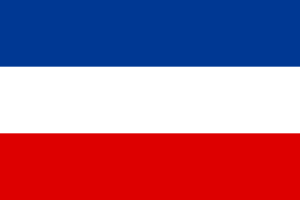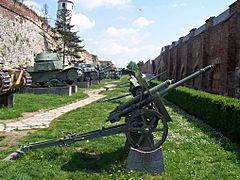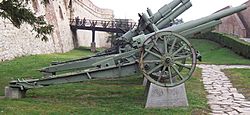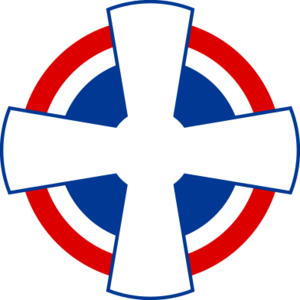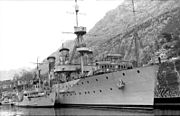Yugoslav order of battle prior to the invasion of Yugoslavia facts for kids
This article is about the Yugoslav order of battle just before the country was invaded in April 1941 during World War II. An "order of battle" is like a list that shows all the military units, their sizes, and where they were located. It helps us understand how a country's army, air force, and navy were set up for a fight.
Before the invasion, Yugoslavia had a large army, but it wasn't fully ready. Many of its weapons and vehicles were old, from World War I. The country also had a small air force and navy. The plan was to place most of the soldiers near the borders, with only a few groups kept back as a backup.
Royal Yugoslav Army
The Royal Yugoslav Army (VKJ) had many soldiers, but they weren't all ready for battle. The army had 29 infantry divisions (large groups of soldiers who fight on foot), three cavalry divisions (soldiers who fight on horseback), and a mountain detachment (a special group for fighting in mountains).
The leader of the army was the 17-year-old King Peter II. The army's main plan was to defend its borders. Most of their transport relied on animals like oxen, not modern vehicles. They only had about 50 modern Renault R35 tanks that could stand a chance against German tanks.
The army was divided into three main groups, called Army Groups, plus two independent armies and a Coastal Defence Command. Many units were still getting ready when the invasion began on April 6, 1941.
Army Groups and Their Roles
The Royal Yugoslav Army was set up in different sections to defend the country. Here's a simple look at how they were organized:
1st Army Group
This group was in charge of defending the borders with Hungary, Italy, and Germany in the northwest. It included the 4th Army and the 7th Army. Many of their units were still getting ready for battle.
2nd Army Group
This group defended the borders near the Danube and Tisza rivers. It included the 1st Army and the 2nd Army. Some of their units were partly ready, while others were still mobilizing.
3rd Army Group
This was a very important group, defending the borders with Albania, Greece, and Bulgaria in the east. Many of the units in this group were fully ready for battle. They were reinforced and prepared for the fight.
5th Independent Army
This army was responsible for the borders with Romania and Bulgaria. It had several infantry divisions and a cavalry division. Some of its units were fully ready, while others were still partly mobilizing.
6th Independent Army
This army was supposed to be the main backup force for the entire army. It was located around Belgrade, the capital city. It had several infantry divisions and detachments.
Coastal Defence Command
This command was in charge of protecting Yugoslavia's coast along the Adriatic Sea. It had infantry divisions and fortress units to defend important areas.
General Headquarters Direct Command
The main army headquarters also had some units under its direct control. These included five infantry divisions and the only operational tank battalion. This tank battalion had older tanks, but a new one with more modern tanks was being formed.
Major Equipment
The Yugoslav Army had a lot of old equipment. Many of their weapons were from World War I. For example, out of 7,000 artillery pieces (large guns), less than 60% were considered modern. Only 50 of their tanks were good enough to fight against German tanks.
Here's a quick look at some of their main equipment:
- Mortars: 1,900
- Light anti-tank guns: 800
- 75mm field guns: 823
- 105mm field howitzers: 180
- World War I-era howitzers: 3,000
- Anti-aircraft guns: 250
- Renault R35 light tanks: 50 (these were the most modern)
- Škoda S-1d light tanks: 50
- Renault NC27 light tanks: 50
- Renault FT and M26/27 light tanks: 50
- Major items of equipment in service with the Royal Yugoslav Army
Royal Yugoslav Army Air Force
By April 1941, the Royal Yugoslav Army Air Force (VVKJ) had a mix of different aircraft. They had 11 types of planes for fighting, 14 types for training, and 5 types for other tasks. These planes used many different engines and weapons, which made it hard to train pilots and keep the planes in good repair.
The VVKJ had a headquarters and four air brigades (large groups of air units). Almost all of their modern planes were from Germany, Italy, or Britain, and they didn't have many spare parts or ammunition for them.
Air Force Headquarters Units
The VVKJ was led by Brigadier Borivoje Mirković. His headquarters had a few special groups directly under its command. These included a long-range reconnaissance group (for scouting far away), a bomber group, and a liaison squadron (for communication). They also had a transport group with civilian airliners used for military transport, and an air training school.
Air Brigades
The VVKJ was organized into four main air brigades:
1st Fighter Brigade
This brigade was mainly made up of fighter planes. It had two fighter regiments, equipped with planes like the Messerschmitt Bf 109E-3a and Hawker Hurricane I. They also had some Yugoslav-made Rogožarski IK-3 fighters.
2nd Mixed Air Brigade
This brigade had both fighter and bomber planes. Its fighter planes included Hawker Hurricane Mk I and Ikarus IK-2 fighters. The bomber planes were Bristol Blenheim Mk I light bombers.
3rd Mixed Air Brigade
This brigade also had a mix of bomber and fighter planes. Its bomber planes were Dornier Do 17K light bombers. The fighter planes were older Hawker Fury Mk II biplanes (planes with two sets of wings).
4th Bomber Brigade
This brigade focused on bomber planes. It had two bomber regiments, flying Bristol Blenheim Mk I light bombers and Savoia-Marchetti SM.79 medium bombers.
Aircraft Types
In April 1941, the Royal Yugoslav Army Air Force had over 423 aircraft. About 107 of these were modern fighter planes. The rest were older and not as good as the planes used by the Axis powers (Germany and its allies).
Here are some of the main types of aircraft they had:
- Fighter aircraft: Messerschmitt Bf 109E-3 (German), Hawker Hurricane Mk I (British), Hawker Fury Mk II biplane (British, older), Ikarus IK-2 (Yugoslav, older), Rogožarski IK-3 (Yugoslav), Avia BH-33E (Czech, older).
- Bomber aircraft: Dornier Do 17Ka (German, medium), Savoia-Marchetti SM 79-I (Italian, medium), Bristol Blenheim Mk I (British, light), Hawker Hind Mk I biplane (British, older, light).
- Reconnaissance aircraft: Caproni Ca.310 (Italian), Breguet 19 (French, older).
- Liaison aircraft: Messerschmitt Bf 108 (German), Fieseler Fi 156 (German).
Between April 6 and 17, 1941, the VVKJ received a few more planes, including some Hawker Hurricanes and Dornier Do 17s.
- Aircraft types in service with the Royal Yugoslav Army Air Force
The Royal Yugoslav Navy (KJRM) was quite small. Its biggest ships were an old German light cruiser (used for training) and a few destroyers (fast warships). Many of their smaller ships were old, inherited from the Austro-Hungarian Empire after World War I. The navy had about 611 officers and 8,562 sailors.
Riverine and Lake Forces
These forces were based on the Danube river and on several lakes. They included:
- River Monitors: These were armored ships designed for river combat. The KJRM had four of these, like the Vardar and Sava, which were old ships from Austria-Hungary.
- Mine Barrage Divisions: These divisions were responsible for laying mines in rivers to stop enemy ships. They had river minelayers and tugboats.
- Lake Detachments: Small groups of boats on Lake Ohrid, Lake Prespa, and Lake Skadar, often using converted customs motorboats.
Maritime Air Force
The navy also had its own air force, called the Maritime Air Force. It used seaplanes (planes that can land on water) for scouting and other tasks. These planes included Ikarus IO biplane flying boats, Rogožarski SIM-XIV-H reconnaissance floatplanes, and Dornier Do 22Kj reconnaissance floatplanes.
This command was responsible for defending the Yugoslav coast. It was divided into three sectors: Northern, Central, and Southern. They had minelayers (ships that lay mines), patrol craft tenders (ships that support smaller patrol boats), and salvage ships.
Torpedo Divisions
The navy had three torpedo divisions:
- 1st Torpedo Division: This was the most powerful, with the flotilla leader Dubrovnik (a large destroyer) and two other destroyers, Beograd and Zagreb. One destroyer, Ljubljana, was being repaired during the invasion.
- 2nd and 3rd Torpedo Divisions: These divisions had smaller torpedo boats, some of which were also old Austro-Hungarian ships.
Submarine Division
The Submarine Division was based in Kotor. It had a submarine tender (a support ship for submarines) called Hvar and four older submarines. These submarines, like Hrabri and Osvetnik, were built in Britain or France.
Miscellaneous Vessels
The KJRM also had other ships not assigned to specific divisions. These included:
- Dalmacija: An old light cruiser used for gunnery training.
- Beli Orao: A gunboat.
- Zmaj: A minelayer that was also a converted seaplane tender.
- Other minelayers and an oil tanker.
- Vessels in service with the Royal Yugoslav Navy
See also
- Hawker Hurricane in Yugoslav service
- List of ships of the Royal Yugoslav Navy



